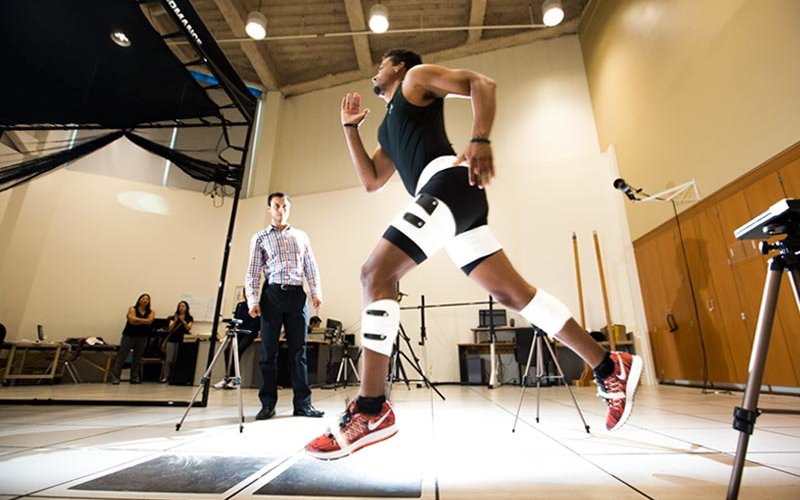
In Cal State Fullerton’s biomechanics lab, kinesiology students are working to understand the development of and possible treatments for knee osteoarthritis — a degenerative condition in which the knee joint gradually wears away and makes it painful to perform everyday activities — following traumatic knee injuries.
One of the most common forms of knee trauma is an anterior cruciate ligament (ACL) injury, with nearly 250,000 occurrences in the United States each year. Thirty to 50 percent of those who experience an ACL injury develop osteoarthritis in their knee joint within five to 10 years following reconstruction.
Mentored by assistant professor of kinesiology, Derek Pamukoff, students have collected data on 90 individuals with the aid of nine state-of-the-art cameras that allow the researchers to create and analyze three-dimensional representations of body movement and patterns.
According to Pamukoff, the students have helped propel the research forward, serving as co-investigators and presenting data as lead authors at national conferences. One such student, recent graduate Mike Vakula ’15, ’17 (B.S., M.S. kinesiology), will continue research on osteoarthritis prevention at Utah State University this fall.
“What’s been exciting for me is getting to apply the knowledge I learned in the classroom and working with lead researchers in the field,” said Vakula. “I couldn’t have come this far without getting so much experience in CSUF’s biomechanics lab.”
One study measures the effectiveness of local muscle vibration (attaching a small vibration device to an individual’s knee) and whole body vibration (having an individual stand on a vibrating platform) on improving quadriceps function. The study was supported through a CSUF Research, Scholarship and Creative Activity Incentive Grant.
“The quadriceps muscles are important because they absorb impact forces that occur in the course of walking. If these muscles don’t function properly, greater force is placed on the knee joint during walking, and this can contribute to joint damage and knee osteoarthritis,” said Pamukoff. “Improving quadriceps function is critical for prevention and treatment of knee osteoarthritis.”
Results of the study indicate that both vibration therapies improve quadriceps function, and pending additional research, could help reduce osteoarthritis-related disability, said Pamukoff.
In a second study, funded by a grant from Cal State University’s Program for Education and Research in Biotechnology (CSUPERB), the researchers are examining the use of ultrasonography as a measure for knee joint health. The purpose of the research is to determine if ultrasound measurements of cartilage thickness, an indicator of osteoarthritis, are related to biomechanical walking patterns and muscle function.
“The ability to take quantitative images using ultrasonography would help us from both a clinical and a research perspective,” said Melissa Montgomery, an assistant professor of kinesiology and athletic trainer who provides clinical insight and interpretation of the studies. According to Montgomery, the current use of magnetic resonance imaging (MRI) and X-ray can be more costly and less accessible.
Both Montgomery and Pamukoff encourage students who are interested in these topics to get involved in research activities.
“We’re always looking for motivated students who want to learn more,” said Pamukoff. “If any of these topics are interesting to students, we encourage them to reach out to us.”